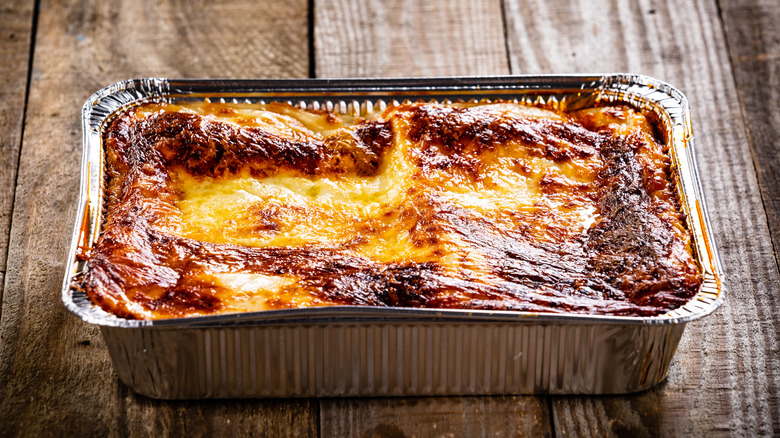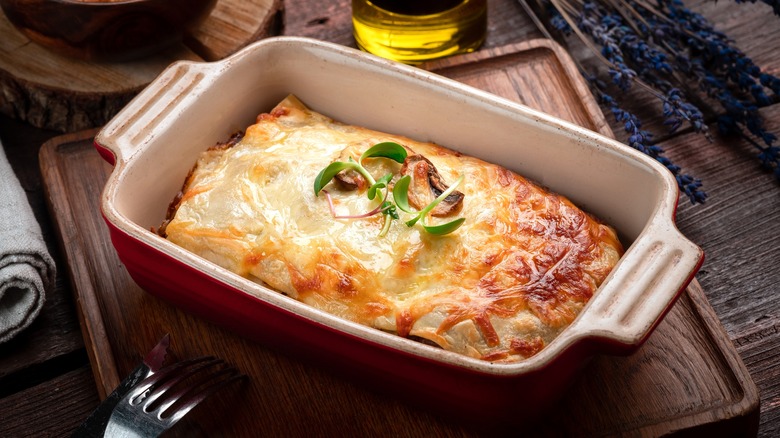This Might Be The Easiest Way To Amp Up Frozen Lasagna
We may receive a commission on purchases made from links.
Lasagna is one of those comfort foods you can enjoy any time of the year. With a little meal prep, you can store it in the freezer for months before baking it, but the flavor and texture might not be as fresh as if you had baked it right away. On the other hand, there's nothing wrong with putting a store-bought frozen lasagna in your cart when you don't have time for meal prepping. In either case, consider making this Italian dish spicy for an added boost of flavor.
That's right: One of the easiest ways to upgrade frozen lasagna is to add a spicy ingredient like chili, red pepper flakes, or chili crisp. Straying from the classic lasagna recipe, this is how author Jon Kung puts a Chinese culinary spin on the Italian dish. His dan dan lasagna recipe in "Kung Food: Chinese American Recipes from A Third-Culture Kitchen: A Cookbook" involves cooking dried, hot red chilies into the sauce and drizzling chili oil over each layer.
Although you're not making your lasagna fresh, you can easily adapt this idea into a frozen version you prepared a month ago or picked up from the store. Right after the dish is done baking, add a sprinkle of your preferred chili crisp or flakes on top and re-cover with foil to heat slightly while it rests. The spices won't be layered throughout, but you'll still get a bit of a kick in each bite.
Other ingredients that can upgrade frozen lasagna
If you aren't a fan of spicy, you can add lots of other ingredients to improve upon the flavors and textures of a frozen lasagna. First, you can scrape off the top layer of cheese and replace it with fresh mozzarella. Scraping off the top will remove extra moisture from accumulated ice, while the mozzarella will add a rich dairy flavor.
While the lasagna is baking, you can sauté some fresh vegetables, such as bell peppers, asparagus, and mushrooms. Consider using butter and garlic to amp up the flavor. Then, add the sautéed veggies on top of the mozzarella about three-quarters of the way through the baking time. You can even add a layer of meat cooked with your own spices and herbs. Before you put it back in the oven to finish, sprinkle a hearty amount of Parmesan over the vegetables to bring out the flavor of the mozzarella while creating a browned top layer of bubbling cheese.
Finally, you can add fresh ground black pepper and chopped parsley or basil when it comes out of the oven. Cover the lasagna with foil to allow the heat to activate the herbs, which will help add freshness to the dish.
Additional tips for preparing and reheating frozen lasagna
If you want to do more than upgrade the flavor of frozen lasagna, make it look like you made it from scratch. To start, transfer the frozen layers from the disposable container to a glass or ceramic baking dish you've greased with cooking oil or spray. Then, let it thaw overnight or up to 12 hours in the refrigerator, and add extra meat, sauce, cheese, and spices to fill any space in the dish.
Since baking a fresh lasagna doesn't take as long as baking a frozen one, you should reduce the manufacturer's cooking time slightly but not too much because of the thicker dish. You can test the internal temperature with a kitchen thermometer, which should read at least 165 degrees Fahrenheit. Luckily, burning the edges a little will only make it look more appetizing and taste better.
Any leftover lasagna stored in the refrigerator will have semi-dry, firm, and chewy layers that can be difficult to distinguish and reheat because some moisture from the sauce and cheese will absorb into the pasta. Using the oven is the best way to reheat lasagna: About 30 minutes at 350 degrees Fahrenheit, covering it with aluminum foil to seal in the remaining moisture. You can also cut 1-inch-thick portions and sear them in a non-stick or cast-iron skillet with butter or oil on a moderate heat setting, allowing them to slowly meld into one as the bottom gets crispy brown.


